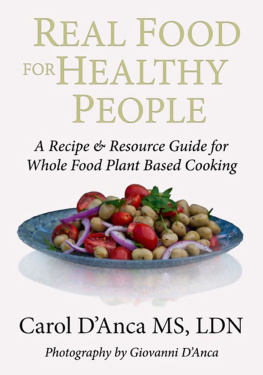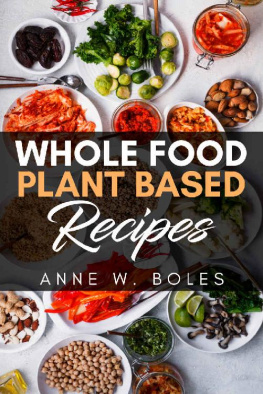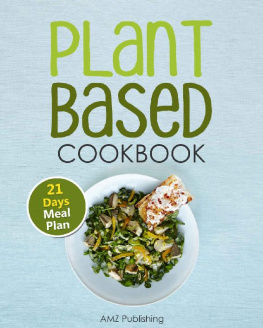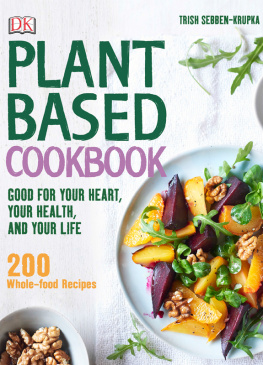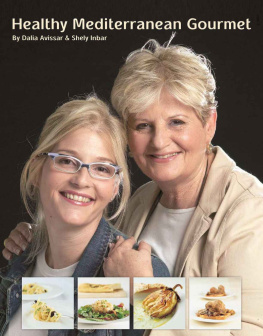PLANT BASED NUTRITION for LIFE
A recipe and resource guide
Real Food for Healthy People
A Resource Guide for Whole Food Plant Based Cooking Copyright 2016 Carol DAnca. All rights reserved.
No part of this book may be reproduced in any form or by any means including graphic, electronic, or mechanical without the express written consent, in writing, from the publisher.
Distributed in the United States by Hippocrates Publishing
eBook ISBN 978-0-692-59346-2
PRINTED IN THE UNITED STATES OF AMERICA
Introduction: The Concept Behind Real Food

Somewhere close behind the need for air and water is the need for food.
-L.J. Martin
How well that describes the point I was at several years ago when I was in need of food and not just any food, but food that would keep me healthy. I knew inherently that the food I was eating wasnt going to keep me healthy much longer, and I knew I was nutrition deprived.
Although I was raised on a typical Mediterranean Diet, it had become far too rich in my adult life with heavy cheeses, desserts, and large portion sizes of food. I loved to cook and I was good at it, but I had reached a stage in my life where I had concerns about rising cholesterol and blood pressure numbers. My suspicions were confirmed while sitting in a doctors office in 2006 and hearing a suggestion that I take cholesterol-lowering medication. As someone who resists even taking an aspirin and has always been opposed to altering my biochemistry with medications, it was a frightening moment and the impetus for change.
But, change, how? What did I really need? It felt strangely odd to me that I didnt have the answers despite the fact that I had formal undergraduate academic training in biochemistry and biology and I had a graduate degree in clinical nutrition. It took a while and then it clicked. Clinical nutrition is just that, clinical, for people with acute and chronic diagnoses. I was looking for preventative nutrition, a different kind of answer.
Dont get me wrong here; Im happy to have the background that I do. It allows me to read a research paper and discern if a study is worthy of merit, and it allows me to understand the bodys chemical processes, our anatomy, how digestion works and a myriad of other things. It was all a great basis for beginning my search but it didnt provide the answer to what I was seeking, despite looking everywhere. I needed to find answers for myself and for my clients who I began noticing were increasingly coming to me wanting to get off medications due to side effects. I saw more and more of what I began calling the holy trinity of commonly prescribed drugs: cholesterol lowering, blood pressure lowering and diabetes controlling medications. It seemed that once that path was taken it was almost impossible to eliminate their continued usage.
Frustrated, but resolved to find an answer, I signed up for a year-long online course in nutrition that gave me an overview of all the dietary theories in place today. Guess what? There are over 100 of them. After close scrutiny I could tell which made sense to me and which I wouldnt even consider as an option for developing and maintaining good health.
After the initial year of study, research, and comparisons, I knew what I wanted and needed: a diet preventing the chronic diseases we suffer from today, such as heart disease, Type 2 diabetes, and cancer. That diet needed to be rich in antioxidants that would combat inflammation, one of the underlying causes of all chronic disease and a diet without high levels of saturated fat, sugar, and white flour. The diet had to be one that eliminated processed foods, virtually anything pre-packaged, and invariably those choices encased in a crinkly wrapper.
My reasons for this? Well, regardless of how confusing the news articles can be about nutrition, one thing is for sure refined white sugar is deadly and we eat plenty of it. Lets be honest and call it a drug rather than food. And despite what the New York Times tells us, average Americans should be eating less saturated fat that comes from meat and dairy if they want to avoid a myriad of problems. There is plenty of research over the last 20 years for that solid conclusion. Fat from these sources raises LDL cholesterol, and when LDL cholesterol gets oxidized in our arteries it causes plaque. When the protective cap on plaque in our arteries ruptures it releases a clot(s), causing heart attacks and strokes. Someone dies of a heart attack or a stroke every minute in the U.S. Reducing animal sources of saturated fat and replacing it with carbohydrates from fruits and vegetables (not refined carbohydrates originating from white sugar and flour) has significantly positive health benefits.
Although I was never a junk food eater and I made just about everything from scratch, I decided to get hyper-vigilant about eliminating the chemicals added to boxed and processed food. I became deeply concerned about the toxins we take in each day, overloading our liver (which has to detoxify our blood) by removing harmful toxins. We are exposed to so many unavoidable toxins from our environment that we dont need to add additional ones in food. I decided to buy foods without a label and to focus mainly on organically grown fruits, vegetables, herbs and grains, all delivering the powerful phytochemicals that we need daily. This all seemed like a tall order, especially paired with not wanting to eat anything with GMOs, refined sugars of any kind, or anything with refined white flour. It sounds daunting but what it all really boils down to is a whole food plant based diet. Now I had something to work with and I was excited!
Armed with the academic learning and a year of my own research identifying real food for a healthy life, I headed to the bookstore to get guidance and recipes needed to start this new eating plan. Wow, was I in for a surprise. I stood in front of four aisles packed with cookbooks hardly knowing where to start. I was undaunted in my efforts and many titles caught my interest.
I found Vegetarian cookbooks with recipes loaded with sugar and fat, Vegan cookbooks loaded with oil and salt, Plant Based cookbooks with recipes that were bland and tasteless, and Mediterranean cookbooks loaded with cheeses, meats and foods that I knew were going to sabotage my efforts by eating them. I found a few good ones that could be adapted, but over time I probably bought 50 books trying to combine a recipe here and there to get a full complement of what I was seeking. After a few months of trying this process I brought them all to Half Price Books for re-sale.
Something else was happening at the same time that I was hunting for recipes; I found myself talking to my clients about a real food only approach to preventing and reversing chronic illness. Curiously they began asking me for recipes and requested that I teach them the culinary skills needed for this type of eating. Simply put, they were telling me they could see the benefits of what I was teaching them, but they didnt know where to start and I couldnt refer them to 50 different cookbooks for answers.
I quickly realized if I was going to give my clients advice to eat real food for a healthy life, they were going to need some help getting started and the food had to taste delicious, be easy to prepare, satiating, healthful, and provide variety so it wouldnt get boring. Wow, what a task I had set up for myself. I was spending countless hours in my test kitchen at home developing new recipes, some from scratch and others that I converted from my own former favorites. Although I wouldnt call myself a chef, Ive had culinary training both in the U.S. and Italy, providing a solid foundation for culinary arts and trying new approaches to cooking and baking. I also come from a family of great cooks and I spent a lot of time in the kitchen watching my mother. Surprisingly, what I found most helpful in this quest was my background in biochemistry! I knew what ingredients to combine to make a batter rise, or thicken a sauce, and I had the confidence to try new and sometimes unusual flours and spices because I could almost see the chemical reactions they would produce to make a tasty and appealing recipe.
Next page
